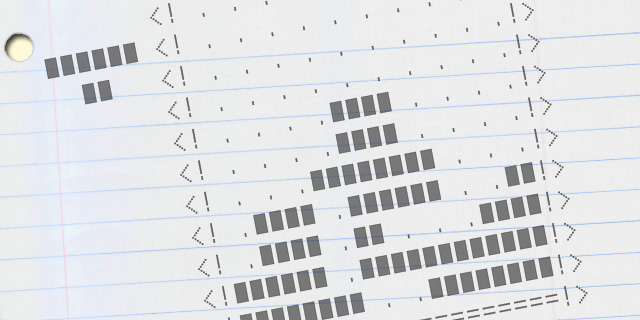
Genre 101 looks at the past and present of a game genre to find lessons about what defines it. In this installment, Andrew Passafiume steps in as host to talk with Graham Russell about the traditional action-puzzler.
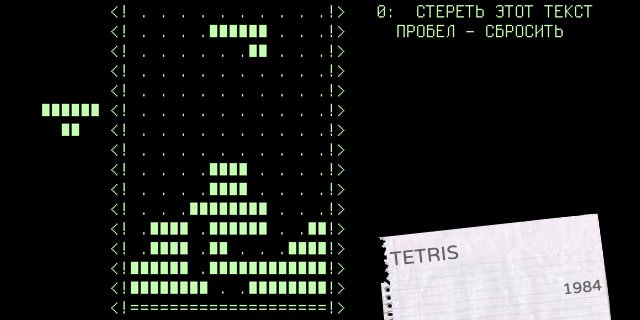
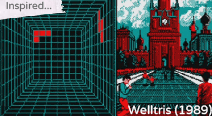
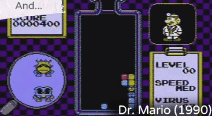
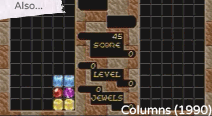
Laying the block foundation
 Graham Russell: It will surprise precisely no one to see that Alexey Pajitnov’s Tetris is the beginning of what would become its own genre. It’s not the first puzzle game, exactly, but that’s why I’m calling it the action-puzzle genre: almost every game is about some sort of puzzle-solving. But Tetris distilled this idea down to a field of blocks, and we’d see much more done with these kinds of constraints than just the usual knock-off. Tetris is most notable for its ability to put players “in the zone,” practically rewiring brains on the fly into tetromino-placement machines.
Graham Russell: It will surprise precisely no one to see that Alexey Pajitnov’s Tetris is the beginning of what would become its own genre. It’s not the first puzzle game, exactly, but that’s why I’m calling it the action-puzzle genre: almost every game is about some sort of puzzle-solving. But Tetris distilled this idea down to a field of blocks, and we’d see much more done with these kinds of constraints than just the usual knock-off. Tetris is most notable for its ability to put players “in the zone,” practically rewiring brains on the fly into tetromino-placement machines.
 Andrew Passafiume: Tetris came out of nowhere and surprised almost everyone when it first launched, opening up a whole new style of puzzle games. It was a simple concept that has been taken in so many different directions with various spinoffs and sequels. Despite that, all of these follow-ups and spiritual successors focus on the basic concept that made the original so successful to begin with. What was it that helped Tetris stand out back in the late ’80s and still makes it such a successful formula even today?
Andrew Passafiume: Tetris came out of nowhere and surprised almost everyone when it first launched, opening up a whole new style of puzzle games. It was a simple concept that has been taken in so many different directions with various spinoffs and sequels. Despite that, all of these follow-ups and spiritual successors focus on the basic concept that made the original so successful to begin with. What was it that helped Tetris stand out back in the late ’80s and still makes it such a successful formula even today?
 What makes a puzzle game great is a combination of simplicity and depth, and no game’s done that better than Tetris. It can be explained in less than 30 seconds, and there is no “mastering” Tetris: in the end, everyone loses. So it has the elements that get people obsessed, and no real end.
What makes a puzzle game great is a combination of simplicity and depth, and no game’s done that better than Tetris. It can be explained in less than 30 seconds, and there is no “mastering” Tetris: in the end, everyone loses. So it has the elements that get people obsessed, and no real end.
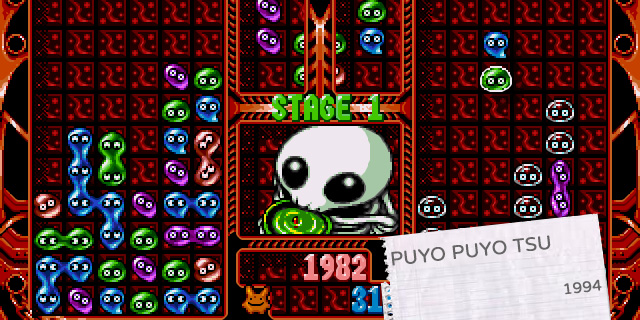
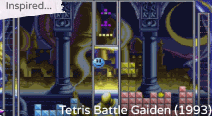
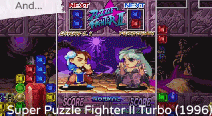
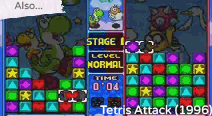
Going head-to-head
 I’ve already written about the East-West puzzle divide, but put simply, it’s Puyo Puyo Tsu that made that happen. It turned the puzzle game concept into something purely competitive, and it did it in such a competent way that it became a phenomenon. Tsu introduced a garbage combo system the first game didn’t have, creating a catch-up mechanic and introducing a risk-vs.-reward strategy that makes it more complicated than just doing everything really fast. It’s essentially the Street Fighter II of action-puzzlers.
I’ve already written about the East-West puzzle divide, but put simply, it’s Puyo Puyo Tsu that made that happen. It turned the puzzle game concept into something purely competitive, and it did it in such a competent way that it became a phenomenon. Tsu introduced a garbage combo system the first game didn’t have, creating a catch-up mechanic and introducing a risk-vs.-reward strategy that makes it more complicated than just doing everything really fast. It’s essentially the Street Fighter II of action-puzzlers.
 With the release of Tetris, the genre seemed to be moving toward solo play despite the fact that it had multiplayer capabilities. Puyo Puyo Tsu proved you can provide a similar concept and make it work more competitively without compromising what makes it so enjoyable to begin with. Was this something puzzle fans were clamoring for, or did it simply come along and surprise everyone? Most importantly, did Puyo Puyo Tsu signal a dramatic shift in the way people approach this genre, or was it simply another successful take on an increasingly popular formula?
With the release of Tetris, the genre seemed to be moving toward solo play despite the fact that it had multiplayer capabilities. Puyo Puyo Tsu proved you can provide a similar concept and make it work more competitively without compromising what makes it so enjoyable to begin with. Was this something puzzle fans were clamoring for, or did it simply come along and surprise everyone? Most importantly, did Puyo Puyo Tsu signal a dramatic shift in the way people approach this genre, or was it simply another successful take on an increasingly popular formula?
 Again, in Japan, it definitely did. By this point in the West, I’m not sure that a genre had to have a successful arcade presence (though Street Fighter and Mortal Kombat were still keeping strong), but across the Pacific, it was a necessity. And at that time, that meant it had to build itself around head-to-head multiplayer. Of course, Tetris itself turned competitive fairly successfully, too, with the best example being the Japan-only Tetris Battle Gaiden.
Again, in Japan, it definitely did. By this point in the West, I’m not sure that a genre had to have a successful arcade presence (though Street Fighter and Mortal Kombat were still keeping strong), but across the Pacific, it was a necessity. And at that time, that meant it had to build itself around head-to-head multiplayer. Of course, Tetris itself turned competitive fairly successfully, too, with the best example being the Japan-only Tetris Battle Gaiden.
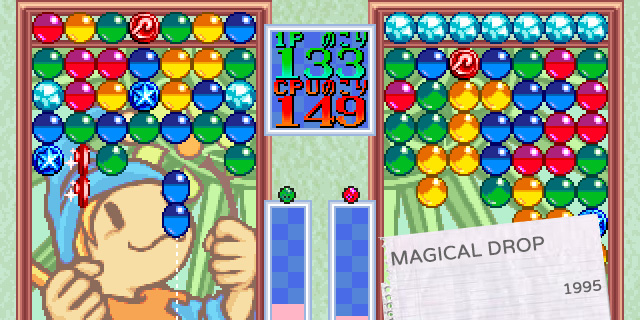
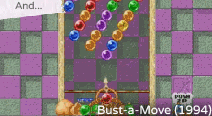

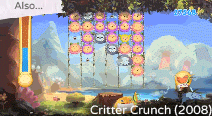
Never stop moving
 There’s a segment of the puzzle genre that’s almost purely about reflexes, and Magical Drop is largely responsible for that branch coming into existence. Sure, you can pull off impressive combos, but the scoring mechanisms and competitive balance push you toward just moving as fast as you can and hoping for the best.
There’s a segment of the puzzle genre that’s almost purely about reflexes, and Magical Drop is largely responsible for that branch coming into existence. Sure, you can pull off impressive combos, but the scoring mechanisms and competitive balance push you toward just moving as fast as you can and hoping for the best.
 Was the sense of speed and focus on reflex-driven gameplay enough to set Magical Drop apart from games like Puyo Puyo or was it something more? I feel the similarities to (as well as the immense popularity of) Puyo Puyo might have stood in the way of Magical Drop’s success, yet it seemed to find an audience despite that.
Was the sense of speed and focus on reflex-driven gameplay enough to set Magical Drop apart from games like Puyo Puyo or was it something more? I feel the similarities to (as well as the immense popularity of) Puyo Puyo might have stood in the way of Magical Drop’s success, yet it seemed to find an audience despite that.
 While games like Puyo Puyo borrowed heavily from fighting games’ competitive elements, Magical Drop took the route of catering to those players’ skills. Being a whiz with arcade controls isn’t enough to be good at most puzzle games. It’s exactly what you need for this type, though, so the distinction usually came from the fact that most favored one heavily over the other.
While games like Puyo Puyo borrowed heavily from fighting games’ competitive elements, Magical Drop took the route of catering to those players’ skills. Being a whiz with arcade controls isn’t enough to be good at most puzzle games. It’s exactly what you need for this type, though, so the distinction usually came from the fact that most favored one heavily over the other.
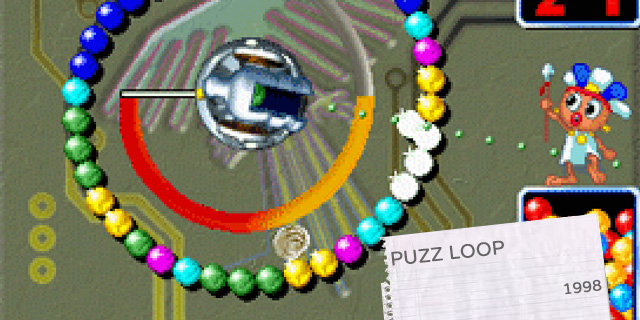
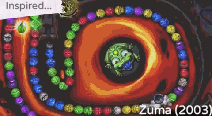
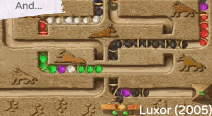
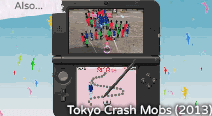
A new twist in gameplay
 You may not know Mitchell’s puzzle game under its original name, but you probably do from the company’s own remakes (Ballistic, Magnetica, Tokyo Crash Mobs) or eerily-similar releases from others (Zuma, Luxor). The origins of the “shoot ball at similarly-colored balls” mechanic lie in Bust-a-Move, but that’s not really the important thing to learn from it. What is? How action-puzzlers have found success in drenching themselves with theme. Fill that screen with ancient Egyptian imagery, Aztec relics or enthusiastic Japanese shoppers, and
You may not know Mitchell’s puzzle game under its original name, but you probably do from the company’s own remakes (Ballistic, Magnetica, Tokyo Crash Mobs) or eerily-similar releases from others (Zuma, Luxor). The origins of the “shoot ball at similarly-colored balls” mechanic lie in Bust-a-Move, but that’s not really the important thing to learn from it. What is? How action-puzzlers have found success in drenching themselves with theme. Fill that screen with ancient Egyptian imagery, Aztec relics or enthusiastic Japanese shoppers, and
suddenly you’re not just playing some abstract pattern-recognition game. (Well, except you totally are.)
 Puzz Loop may not be the most recognizable name on this list, but its impact is undeniable. Like you mentioned, it’s not just about pattern recognition anymore. Puzz Loop demonstrated you could take a well-worn concept, add a small twist and make it stand out while still maintaining everything people love about this style of puzzle games to begin with. The fact that we’re still getting various new spinoffs and clones of Puzz Loop, including bizarre titles such as Tokyo Crash Mobs, proves that you can do a lot with a little.
Puzz Loop may not be the most recognizable name on this list, but its impact is undeniable. Like you mentioned, it’s not just about pattern recognition anymore. Puzz Loop demonstrated you could take a well-worn concept, add a small twist and make it stand out while still maintaining everything people love about this style of puzzle games to begin with. The fact that we’re still getting various new spinoffs and clones of Puzz Loop, including bizarre titles such as Tokyo Crash Mobs, proves that you can do a lot with a little.
 And it also shows how, when companies hit upon a successful formula, are going to ride it out as long as possible. That’s smart, really; the chance of a puzzle game’s success is roughly the same as that of a movie script getting filmed and released, which is to say not great. And if the puzzle game’s good enough, we don’t so much mind getting a lot of it either.
And it also shows how, when companies hit upon a successful formula, are going to ride it out as long as possible. That’s smart, really; the chance of a puzzle game’s success is roughly the same as that of a movie script getting filmed and released, which is to say not great. And if the puzzle game’s good enough, we don’t so much mind getting a lot of it either.
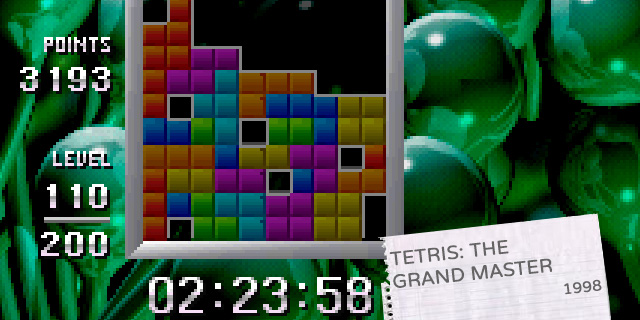
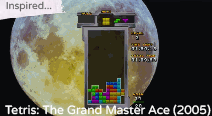
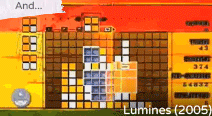
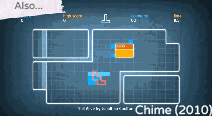
Relying on pure skill
 Generally, action-puzzle games have moved toward casual-friendly concepts, but there’s a segment that took that opportunity to stop being friendly to anyone at any time. Watching someone play Tetris: The Grand Master is like staring into the Matrix, as it starts at a feverish pace and just gets faster. It’s exactly this crowd that you’ll run into if you ever play a puzzle game’s online mode, and it’s a different thing than watching a master FPS player: there are intense calculations going on in a Grand Master player’s head that rival that of any chess expert and in way less time. Games like this can be incredibly rewarding, if you dedicate your life to learning them.
Generally, action-puzzle games have moved toward casual-friendly concepts, but there’s a segment that took that opportunity to stop being friendly to anyone at any time. Watching someone play Tetris: The Grand Master is like staring into the Matrix, as it starts at a feverish pace and just gets faster. It’s exactly this crowd that you’ll run into if you ever play a puzzle game’s online mode, and it’s a different thing than watching a master FPS player: there are intense calculations going on in a Grand Master player’s head that rival that of any chess expert and in way less time. Games like this can be incredibly rewarding, if you dedicate your life to learning them.
 This was the game for those dying to show off their Tetris skills. It’s even more about speed and reflexes than any prior release in the series (and possibly any prior action-puzzle title). Do you think this was all the Tetris formula needed to gain traction once again, or was it a game that hit at just the right time like the original?
This was the game for those dying to show off their Tetris skills. It’s even more about speed and reflexes than any prior release in the series (and possibly any prior action-puzzle title). Do you think this was all the Tetris formula needed to gain traction once again, or was it a game that hit at just the right time like the original?
 I don’t think Tetris ever lost traction, but what defined the Tetris experience had been static for a number of years before Grand Master debuted. It’s an example of how to extend the life of a game by drawing in new fans and turning it into a somewhat unfamiliar concept for players to learn and explore.
I don’t think Tetris ever lost traction, but what defined the Tetris experience had been static for a number of years before Grand Master debuted. It’s an example of how to extend the life of a game by drawing in new fans and turning it into a somewhat unfamiliar concept for players to learn and explore.
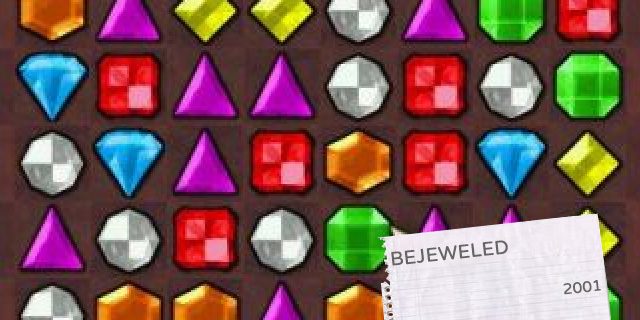
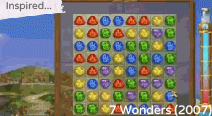
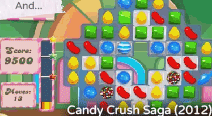
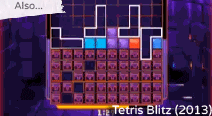
Shiny happy puzzles
 I’m not sure I know anyone who hasn’t played a tile-swapping game at this point, and it’s all PopCap’s fault. Bejeweled (originally Diamond Mine) wasn’t the first of its kind; Shariki and Tetris Attack, among others, did the match-three thing way earlier. But PopCap injected its mastery of classical conditioning, and the deluge of mobile clones in recent years did nothing but magnify the game’s compulsive effects.
I’m not sure I know anyone who hasn’t played a tile-swapping game at this point, and it’s all PopCap’s fault. Bejeweled (originally Diamond Mine) wasn’t the first of its kind; Shariki and Tetris Attack, among others, did the match-three thing way earlier. But PopCap injected its mastery of classical conditioning, and the deluge of mobile clones in recent years did nothing but magnify the game’s compulsive effects.
 Like Tetris before it, Bejeweled seemed to hit at just the right time and became an instant sensation. What was it about Bejeweled that made it click with people considering it wasn’t the first take on this particular style of action-puzzler?
Like Tetris before it, Bejeweled seemed to hit at just the right time and became an instant sensation. What was it about Bejeweled that made it click with people considering it wasn’t the first take on this particular style of action-puzzler?
 Like I said, PopCap knows how to mess with players’ minds. Think Peggle. Think Plants vs. Zombies. There’s something about that company’s style that keeps players hooked, and in today’s iOS and Facebook arenas, everyone’s chasing that sort of success.
Like I said, PopCap knows how to mess with players’ minds. Think Peggle. Think Plants vs. Zombies. There’s something about that company’s style that keeps players hooked, and in today’s iOS and Facebook arenas, everyone’s chasing that sort of success.
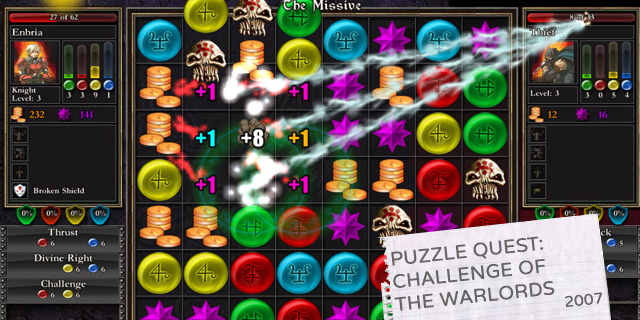
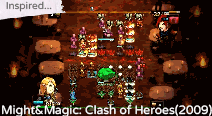
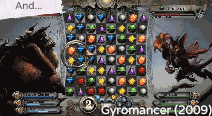
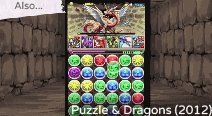
Embracing the hybrid model
 As with many genres in recent years, the action-puzzle formula has been involved in hybridization attempts, but Puzzle Quest may be the first true success that spawned many others. Adding progression mechanics to a puzzler takes a compelling experience and basically turns it into the battle system of an RPG. It’s not the only game of its kind, either: a personal favorite, Might & Magic: Clash of Heroes, even incorporates tactical strategy aspects, to great effect.
As with many genres in recent years, the action-puzzle formula has been involved in hybridization attempts, but Puzzle Quest may be the first true success that spawned many others. Adding progression mechanics to a puzzler takes a compelling experience and basically turns it into the battle system of an RPG. It’s not the only game of its kind, either: a personal favorite, Might & Magic: Clash of Heroes, even incorporates tactical strategy aspects, to great effect.
 I remember when Puzzle Quest was first introduced. The idea seemed fresh and, as it turns out, the actual execution of that idea was brilliant. It seemed like an obvious move, yet we hadn’t seen anything like it prior. Why do you think it took so long for a game like Puzzle Quest to come along? Also, do you think the potential is there for another huge breakthrough in this increasingly popular trend of genre hybridization, especially regarding puzzle games?
I remember when Puzzle Quest was first introduced. The idea seemed fresh and, as it turns out, the actual execution of that idea was brilliant. It seemed like an obvious move, yet we hadn’t seen anything like it prior. Why do you think it took so long for a game like Puzzle Quest to come along? Also, do you think the potential is there for another huge breakthrough in this increasingly popular trend of genre hybridization, especially regarding puzzle games?
 The best new ideas are the ones that seem obvious in retrospect, but that doesn’t make them any less great. As for other hybrids, we’ve already seen quite a bit: Henry Hatsworth merged it with an action-platformer, Slam Bolt Scrappers brought in both brawling and tower defense and both Chime and Lumines incorporated rhythm elements. But RPGs work best, simply because the worst part of an RPG is typically its repetitive battle system, and replacing it with a great puzzle game? You never get tired of that.
The best new ideas are the ones that seem obvious in retrospect, but that doesn’t make them any less great. As for other hybrids, we’ve already seen quite a bit: Henry Hatsworth merged it with an action-platformer, Slam Bolt Scrappers brought in both brawling and tower defense and both Chime and Lumines incorporated rhythm elements. But RPGs work best, simply because the worst part of an RPG is typically its repetitive battle system, and replacing it with a great puzzle game? You never get tired of that.
GIFs by Christian Stewart.



















